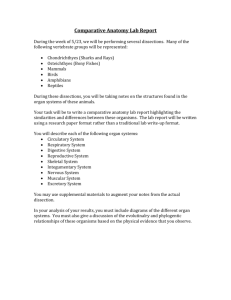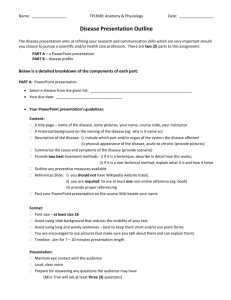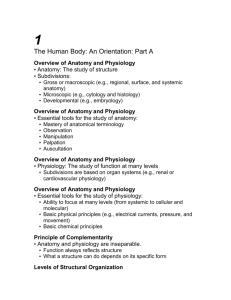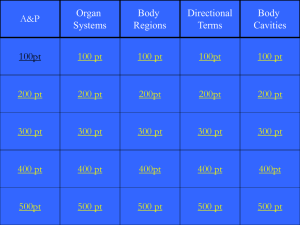Determining the Anatomy and Physiology of Animals
advertisement
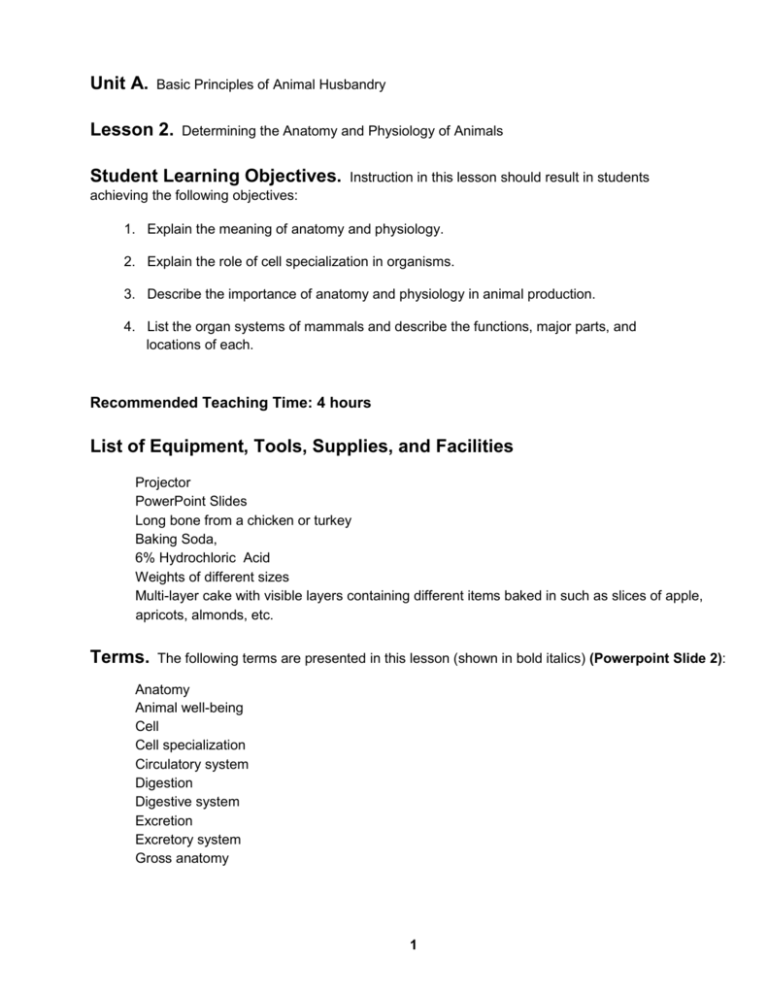
Unit A. Basic Principles of Animal Husbandry Lesson 2. Determining the Anatomy and Physiology of Animals Student Learning Objectives. Instruction in this lesson should result in students achieving the following objectives: 1. Explain the meaning of anatomy and physiology. 2. Explain the role of cell specialization in organisms. 3. Describe the importance of anatomy and physiology in animal production. 4. List the organ systems of mammals and describe the functions, major parts, and locations of each. Recommended Teaching Time: 4 hours List of Equipment, Tools, Supplies, and Facilities Projector PowerPoint Slides Long bone from a chicken or turkey Baking Soda, 6% Hydrochloric Acid Weights of different sizes Multi-layer cake with visible layers containing different items baked in such as slices of apple, apricots, almonds, etc. Terms. The following terms are presented in this lesson (shown in bold italics) (Powerpoint Slide 2): Anatomy Animal well-being Cell Cell specialization Circulatory system Digestion Digestive system Excretion Excretory system Gross anatomy 1 Integumentary system Lymph Lymphatic system Mammal Mammary system Microscopic anatomy Muscular system Nervous system Organ Organ system Physiology Respiratory system Reproductive system Skeletal system Tissue Interest Approach. Use an interest approach that will prepare the students for the lesson. Teachers often develop approaches for their unique class and student situations. A possible approach is included here: Ask students to describe what functions an animal organism must perform to carry out life processes. List these on the writing surface. Examples include respiration, digestion, and elimination. Next, ask students how organisms are able to carry out these functions-they have body parts or organ systems that make it possible for these functions to occur. Have students name and discuss specific examples, such as the mammary system of a dairy cow secretes milk used as food for her calf as well as for human food. Move from this interest approach into the lesson. Summary of Content and Teaching Strategies Objective 1: Explain the meaning of anatomy and physiology. Anticipated Problem: What is the meaning of anatomy and physiology? (Powerpoint Slide 3) I. Animals are complex organisms with systems and processes that allow them to carry out activities to remain in the living condition. A. Anatomy is the study of the form, shape, and appearance of an animal. Since mammals are among the most common animals, most of the information on anatomy will focus on these animals. (Powerpoint Slide 4) 1. Gross anatomy deals with the features that can be seen with the unaided eye. Examples include feet, horns, tails, tongues, and teeth. 2. Microscopic anatomy deals with the features that can only be seen with magnification. Examples include cells and sperm. (Powerpoint Slide 5) 2 B. Physiology is the study of the functions of the cells, tissues, organs, and organ systems of the living organism. 1. Physiology includes relationships among functions by different systems of an organism, such as secretion to digestion. 2. Diseases can cause the systems to fail to work properly. (Powerpoint Slide 6) **Have students illustrate the words anatomy and physiology. Each letter should be illustrated to help them understand the meaning of the word. For example, the “t” in anatomy may look like a femur bone. Also, . Use TM: 2-1 to present a definition of the key terms. Have students give examples of anatomy and physiology in animals that they have as companions or for production. Objective 2: Explain the role of cell specialization in organisms. Anticipated Problem: What is cell specialization? Why is it important? II. Cells are the building blocks of organisms. A cell is the basic structure of life. Cells have important structures that allow them to function. Protoplasm within a cell carries out important chemical activities. Multi-cellular organisms have many cells. These cells form specialized systems to carry out life processes. (Powerpoint Slide 7) A. Cell specialization is different in each cell in order to perform unique activities for an organism. Organisms could not exist if all cells were alike. 1. A tissue is a group of cells that is alike in activity and structure. The functions tend to be specialized such as those in muscles or bones. (Powerpoint Slide 8) 2. An organ is a group of tissues that work together to perform specific functions. Each tissues' job varies, but by working together the organ carries out its function. Examples of organs include the heart, lungs, and liver. (Powerpoint Slide 9) 3. An organ system is a collection of several organs that work together to perform an activity. Two examples are the respiratory system and digestive system. (Powerpoint Slide 10) B. Cell specialization is important because it makes multi-cellular organisms possible. Without specialization, all cells would be alike. Tissues, organs, and organ systems would not exist. Life processes in multi-cellular organisms would not occur. (Powerpoint Slide 11) **To reinforce this objective, assign groups of students to act out the function of a tissue, an organ, or an organ system. Students can do this independently or in groups. For example, a student may be assigned “organ” and they would act out air passing in and out of the lung. The remainder of the class would try to guess the correct answer. Also use TM: 2-2. The relationship also needs to be drawn that without cells, tissues would not exist, without tissues, animals would not have organs and etc. Ask students to name examples of tissues, organs, and organ systems. Give positive reinforcement as they answer correctly. To reinforce this objective, ask students what the 3 types of cell specialization are. They should respond in unison “Tissues, Organs, and Organ Systems” Repeat this as a form of review. 3 Objective 3: Describe the importance of anatomy and physiology in animal production. Anticipated Problem: What is the importance of anatomy and physiology in animal production? (Powerpoint Slide 12) III. People who care for animals need to understand the fundamentals of anatomy and physiology. A. Practicing the correct nature of anatomy and physiology of an organism promotes animal well-being. Animal well-being is caring for animals so that their needs are met and they do not suffer. Conditions for raising and keeping animals must be considered for their well-being. (Powerpoint Slide 13) 1. Species have different environmental requirements. Animal producers are more effective in meeting these requirements when they know the unique anatomy and physiology of a species. (Powerpoint Slide 14) For example, some breeds of cattle are more resistant to extreme temperatures than others. Producing a breed outside its preferred temperature range means that steps need to be taken to provide shade to protect from the heat or housing to protect from the cold. (Powerpoint Slide 15 & 16) Also be sure to give illustrations of breeds of cattle native to the area. Draw a relationship in ways that they have adapted to live in the climate. How would cattle from other countries fair in Afghanistan? Not very well because they are not accustomed to the climate. 2. The design of facilities can accommodate the unique anatomy needs of organisms. The size, shape, and form influences facility arrangement and design. For example, keeping dairy cattle housing clean requires a way to handle animal wastes, including feces and urine. Facility design can help collect and remove wastes from the area. (Powerpoint Slide 17) Have students give examples of animal housing facilities in the area. Students could also design their own animal housing facility on a sheet of paper. 3. Young animals require different care than older animals. Feed for young animals should be appropriate to its digestive system and nutrient needs. For example, young animals typically require feed with a higher percentage of protein than older animals. (Powerpoint Slide 18) B. Animal productivity is based on animal capacity. (Powerpoint Slide 19) 1. Meat animals are required to have muscling in areas that are used to make the higher-priced cuts. Examples include the loin and leg of sheep 2. Dairy animals need to have the capacity for high milk production. For example, a dairy cow needs a well-developed mammary system. (Powerpoint Slide 20) 3. Animals used for other products are required to have the capacity to produce those products, including egg-laying capacity of chickens and wool quality of sheep. 4. Knowing how animals reproduce helps a producer provide conditions that promote reproduction. (Powerpoint Slide 21) **Ask students to remember the last time they were sick. What did they feel like? How did they know they were sick? Could it have been prevented? Now, ask students what happens when an animal gets sick. Who do they rely on to help them? Relate this to having a good knowledge of animal anatomy and physiology. Students can name examples in the local area where animal well-being is practiced properly and where it is ignored so that the animals are not in a good situation. Outline the major areas on the writing surface or use TM: 2-3. 4 Objective 4: List the organ systems of mammals and describe the functions, major parts, and locations of each. Anticipated Problem: What are the organ systems of mammals? What are the functions, major parts, and locations of each? (Powerpoint Slide 22 – 24) or Use TM: 2-4, TM 2-5, and TM: 2-8 to list on a writing surface and discuss the major organ systems, their functions and their parts. IV. A mammal is a vertebrate animal that is usually covered with hair. The females give birth to live young and secrete milk as food for their babies. Cattle, sheep, horses, dogs, cats, and many other common animals are mammals. Each mammal species has unique organ systems that promote the life processes of the species. A. Mammal species are said to have eleven organ systems. Some variation may exist, with the greatest being the presence of mammary glands on females. 1. The skeletal system is the framework that gives shape to the body. The skeleton is comprised of bones and cartilage. The skeletal system protects the delicate internal organs and makes locomotion possible. (Powerpoint Slide 25-28) **Find an appropriate long bone, such as a long chicken or turkey bone. Wash it in baking soda and then soak it in 6% hydrochloric acid for 24 hours, rinse the bone. The bone will be very flexible; you may even be able to tie it into a knot. Ask the students to determine why the bone is flexible? Also, use TM: 2-7, TM: 2-9, & TM: 2-10. 2. The muscular system is the system that makes movement and locomotion possible. Muscles form nearly half the weight of many animals such as sheep and cattle. Without muscles, other organ systems would not function such as the respiratory and circulatory systems. Locomotion would not be possible. (Powerpoint Slide 29) **Bring in a variety of weights of different sizes. Have the students try lifting each of the weights, to see how easy or hard it is to lift each of the weights. Have them record their answers on a sheet of paper. After each of the students has tried out the weights, discuss why some students found it easier or more difficult to lift some weights than others. Lead this into a discussion on muscles. 3. The nervous system is the system that coordinates body activity. It receives and responds to stimuli. It controls activity, learning, and memory. (Powerpoint Slide 30) 4. The circulatory system is the system that moves blood, digested food, oxygen, wastes, and other materials around the body of an organism. It includes the organs that move the blood. The heart moves the blood throughout the body. It goes by the lungs to gain oxygen and give off carbon dioxide acquired from cell respiration. (Powerpoint Slide 31-33) and TM: 2-6. **Ask students to think about the water that flows down the irrigation ditches. The drops of water take different paths or channels to get nourishment to the plants. The circulatory system in animals is very similar in that the drops of blood have with many different paths it can travel. 5. The respiratory system is the system that moves gases to and from the circulatory system. The purpose is to provide the blood with oxygen and remove carbon dioxide from the blood. (Powerpoint Slide 34) 6. The excretory system is the system that rids the body of wastes from cell activity (known as metabolic wastes). The process of ridding the body of these wastes is known as excretion. Though associated with the elimination of undigested food, the excretory system is not the digestive system. The major products excreted are carbon dioxide, water, and nitrogen compounds. (Powerpoint Slide 35 & 36) 5 7. The digestive system is the system that prepares food for use by the body. Digestion is the process of breaking down food materials into molecules that the body can absorb. The system varies depending on the species of organism. Some organisms, such as cattle, have digestive systems that will handle considerable roughage. Other organisms have simple stomachs that require food with higher percentages of protein and digestible materials. (Powerpoint Slide 37-39) 8. The lymphatic system is the system that produces and circulates lymph throughout the body. Lymph is a clear fluid that aids in circulation, excretion, and other body functions. It also helps protect the body from disease. (Powerpoint Slide 40) 9. The integumentary system is the skin and outer covering of the body of an organism. It protects the internal organs, helps regulate temperature, and gives shape to the body. The integumentary system keeps disease pathogens away from the internal organs. (Powerpoint Slide 41) **Bring in a multi-layer cake that is cut in half so that the layers are visible. The cake should have different items baked into it, such as slices of apple, apricots, almonds, etc. Use the cake as a springboard to talk about the purpose of the frosting as the skin and the cake as the internal body parts. The frosting is helpful in preventing the inside of the cake from drying out, just like the epidermis. Begin talking about skin and everyone can have a small piece of the cake to eat. 10. The reproductive system is the system that produces offspring and continues the existence of a species. The system varies by gender-male and female. (Powerpoint Slide 42 & 43) 11. The mammary system is the system in female mammals that secretes milk as food for their babies. Male mammals have undeveloped mammary systems. (Powerpoint Slide 44) B. Most animals tend to have the same organ systems except that mammals have mammary systems that are not found in non-mammals. The reproductive system varies by the gender of the animal. (Powerpoint Slide 45 & 46) 1. The parts of the organ systems have been identified and studied by scientists in anatomy and physiology. 2. Drawings have been made that show the location and structure of the major parts of organ systems. These were prepared by scientists who have studied the anatomy of animals in great detail. **Along with the activities throughout the lesson, have students develop a “Body Systems Booklet” to collect important information about each of the body systems. At a minimum have students collect the purpose of the body system and the main organ involved. Use the powerpoint slides provided to help illustrate what each of the organ systems look like and where they are found in the animals. Have students sketch the organ systems in their booklets. Students could also take turns sketching the organ systems on the writing surface. Be sure to ask questions about the organ systems during the lecture. Questions such as “Why is this system important?”, or “What would happen if the animal lacked this organ system?” would be beneficial. 6 Review/Summary. The review and summary should be organized around the objectives for the lesson. Using the booklets created, students should be able to review material independently or in pairs. Use observations of student performance as a basis for reteaching areas where students appear not to have achieved satisfactorily. (Powerpoint Slide 47) Application. Application will be achieved throughout the class and other classes as students study animal production. The content of this lesson is fundamental in those classes. Evaluation. Evaluation should be based on student achievement of the objectives. Observe student performance during the instruction as well as later in application opportunities. Review of each student's notebook will also be useful in evaluation. A written test may be given. A sample test is attached. Answers to Sample Test A2-1: Part One: Matching 1=i, 2=e, 3=a, 4=f, 5=c, 6=d, 7=b, 8=h, 9=j, 10=g Part Two: Completion 1=integumentary, 2= muscular, 3=skeletal, 4=digestive, and 5=circulatory Part Three: Short Answer 1. The answer should address the ability of a producer to provide for the well-being of the animal. The answer should also include animal selection for a particular use. 7 Sample Test A2-1 Name_____________________________________ Test Part One: Matching Instructions. Match the term with the correct response. Write the letter of the term by the definition. a. b. c. d. e. animal well-being anatomy physiology tissue organ f. g. h. i. j. organ system excretion digestion lymph mammal _______ 1. A clear fluid that aids circulation, excretion, and other body functions. _______ 2. A group of tissues that work together to perform specific functions. _______ 3. Caring for animals so that their needs are met and they do not suffer. _______ 4. A collection of organs that work together to perform a function for an organism. _______ 5. The study of the functions of cells, tissues, organs, and organ systems of a living organism. _______ 6. A group of cells that is alike in activity and structure. _______ 7. The study of the form, shape, and appearance of an animal. _______ 8. Breaking down food into molecules that the body can absorb. _______ 9. A group of animals that are covered with hair, and in which the females give birth to live young and secrete milk as food for their babies. _______ 10. The process of the body ridding itself of wastes. Part Two: Completion Instructions. Provide the word or words to complete the following statements. 1. The __________________ system consists of skin and other body covering. 2. The __________________ system makes body movement possible. 3. The __________________ system provides a framework to give the body shape. 4. The __________________ system prepares food for use by the body. 8 5. The __________________ system moves blood and other materials throughout the body of an animal. Part Three: Short Answer Instructions. Provide information to answer the following questions. 1. Why is knowledge of anatomy and physiology important to animal producers? 9 TM: 2-1 Anatomy and Physiology of Animals Anatomy—study of the form, shape, and appearance of animals • Gross anatomy—study of the anatomy features that can be seen with the unaided eye Microscopic anatomy—study of the anatomy features that require magnification Physiology—study of the functions of cells, tissues, organs, and organ systems of a living organism 10 TM: 2-2 Building Blocks Cell—basic structure of a living organism; contains protoplasm which carries out important chemical activities Cell specialization—differences in cells so that they can perform unique activities Tissue—a group of cells that are alike in structure and activity Organ—a group of tissues that work together to perform a specific function Organ system—a collection of organs that work together to perform a function essential for the living condition 11 TM: 2-3 Why is it important to know about Anatomy and Physiology? promotes animal well-being o Animal well-being—caring for animals so that their needs are met; animals do not suffer consider environmental needs of animals provide facilities to meet needs provide care based on age and condition consider animal production capacity in selection 12 TM: 2-4 Organ Systems and Functions skeletal—framework for body muscular—makes movement and locomotion possible nervous—coordinates body activities and respond to stimuli circulatory—moves blood and its contents in body respiratory—moves gases to and from the circulatory system excretory—rids body of metabolic wastes digestive—prepares food for digestion and eliminates undigested food materials lymphatic—produces and circulates lymph integumentary—protects and shapes the body exterior reproductive—produces offspring; varies by gender mammary—present in female mammals; secretes milk 13 TM: 2-5 Major Organ System Parts skeletal—bones and cartilage muscular—muscles and connective tissues nervous—brain, spinal cord, and nerves circulatory—heart, arteries, and veins respiratory—lungs excretory—kidneys, bladder, urethra, and skin digestive—mouth, stomach, and intestines lymphatic—lymph nodes and lymph vessels integumentary—skin, hooves, claws, and other exterior parts reproductive—varies by gender-testes in males; ovaries in females mammary—milk glands and udder 14 TM: 2-6 Circulatory System of a Horse Heart Kidneys Lungs Arteries Veins Liver Blood vessels to the large intestine Artwork supplied with permission of Interstate Publishers, Inc. 15 TM 2-7 16 TM 2-8 17 TM 2-9 Skeletal System of Poultry 18 TM 2-10 19


